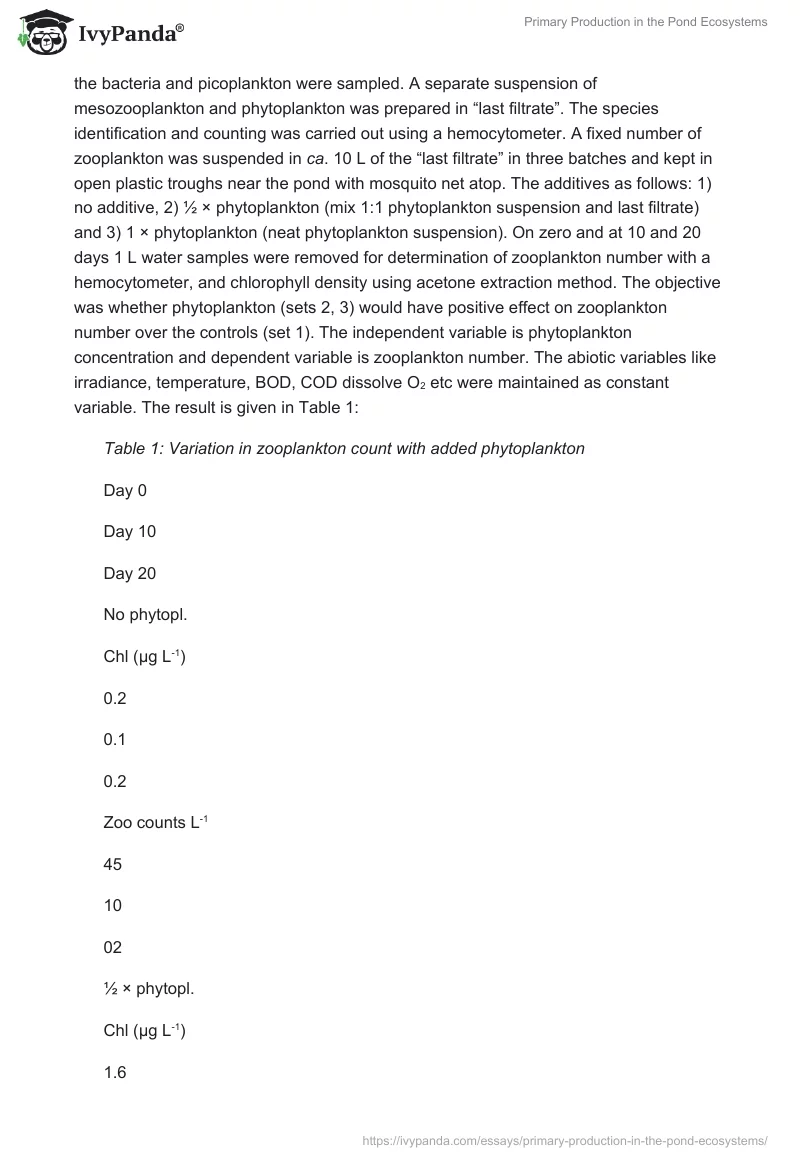In freshwater lake and oceanic ecosystems phytoplankton (free-floating plants) are the primary producers within the littoral and upper pelagic zones in water columns, responsible for trapping and converting light energy into biomass. The primary consumers are the herbivore zooplankton (free-floating animals) of diverse size: >1 mm (macrozooplankton), 200-1000 µm (mesozooplankton) and 20-200 um (microzooplankton) and >20 µm (pico zooplankton), constituted by small protozoan to intermediate rotifers and ciliates and to large copepods and aquatic insects. The third community is decomposers mostly of bacteria and other heterotrophic organisms, and termed as bacterioplankton. In aquatic food webs the primary consumers are the herbivore zooplankton, mostly feeding on phytoplankton and occasionally also on bacterioplankton. The secondary and tertiary consumers graze on the herbivore zooplankton and that is how energy is transferred in trophic level (Odum & Barrett, 2005). In small eutrophic lakes and ponds in tropical and subtropical region phytoplankton populates, and later mesozooplankton species like Daphnia and Moina graze on them. We do observe periodic succession of dominant regimes of zooplankton and phytoplankton communities at different times of a year.
A question was asked – what would happen if primary producers, namely phytoplankton in lakes suddenly disappeared, and whether then the herbivore mesozooplankton would change feeding preference to bacteria rather than algae? We hypothesize that if such conditions prevailed then for survival the zooplankton would still continue to flourish by feeding on planktonic bacteria and picoplankton species and food web would remain unaffected. If this hypothesis is correct we would predict that in a pilot-scale experiment the tested zooplankton population size in lake water would increase even though no phytoplankton species is added as feed, assuming that the bacterial and picoplankton communities would still suffice for feeding.
We created a miniaturized microcosm of a freshwater lake ecosystem. Mesozooplankton were trapped in sample bottles by skimming plankton net with Nitex nylon 200 µm pore size through the water surface. The filtrate was then passed through another differential filter of 20 µm to trap the phytoplankton cells and in the “last filtrate” the bacteria and picoplankton were sampled. A separate suspension of mesozooplankton and phytoplankton was prepared in “last filtrate”. The species identification and counting was carried out using a hemocytometer. A fixed number of zooplankton was suspended in ca. 10 L of the “last filtrate” in three batches and kept in open plastic troughs near the pond with mosquito net atop. The additives as follows: 1) no additive, 2) ½ × phytoplankton (mix 1:1 phytoplankton suspension and last filtrate) and 3) 1 × phytoplankton (neat phytoplankton suspension). On zero and at 10 and 20 days 1 L water samples were removed for determination of zooplankton number with a hemocytometer, and chlorophyll density using acetone extraction method. The objective was whether phytoplankton (sets 2, 3) would have positive effect on zooplankton number over the controls (set 1). The independent variable is phytoplankton concentration and dependent variable is zooplankton number. The abiotic variables like irradiance, temperature, BOD, COD dissolve O2 etc were maintained as constant variable. The result is given in Table 1:
Table 1: Variation in zooplankton count with added phytoplankton
In absence of phytoplankton there was a sharp decrease in zooplankton population size as a function of time suggesting that picoplankton and bacterioplankton are most likely not grazed. With increase in phytoplankton density to half pond density, a time-dependent increase in zooplankton number was noticed. Delivering phytoplankton density equal to what is present in the pond, led to further increase in the zooplankton number with progression of time. Moreover, the phytoplankton density (chlorophyll content) also increased from day 0 in course of experiment. This suggests that the increase of phytoplankton population outnumbered the population that was grazed by zooplankton. Since the zooplankton population size grew only when the phytoplankton population was present, our hypothesis was rejected. As phytoplankton density also increased in the experiment we could have had another set of variables, that is, fixed phytoplankton and changing zooplankton population size. Further, it would be important to monitor the predicted constant abiotic variables during the experimental period. This experiment proves that in pond ecosystems due to trophic interaction, primary production is essential for the consumers to increase population size, which has no correlation with the picoplankton and bacterial population present in that ecosystem.
Source
Odum, E.P. & Barrett, G.W. (2005). Fundamentals of Ecology (5th ed.). Florence, KY: Brooks/Cole, CENGAGE Learning.


